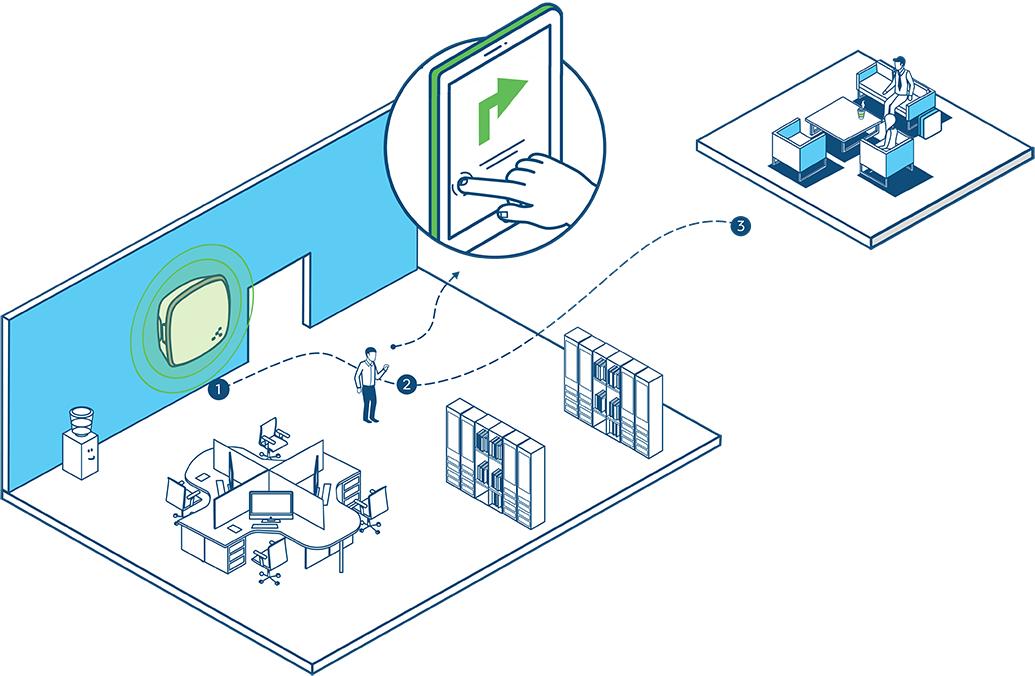
The IoT technology has been constantly updated and iterated, and the indoor positioning technology has also undergone earth shaking changes. From room level positioning, decimeter level positioning to high-precision centimeter positioning, the evolution of technology is always unexpected! In the indoor positioning solutions, various positioning technologies appear in turn. Which technology is the most suitable for indoor positioning? Next, from a 360 degree perspective, learn about the Bluetooth indoor positioning technology solutions.
1、 Overview of Bluetooth indoor location technology
The core of the Bluetooth indoor positioning technology is to deploy and install Bluetooth gateway equipment in the environment, passively capture the beacon information transmitted by the Bluetooth beacon on the person/object through the Bluetooth gateway, the Bluetooth gateway will return the collected beacon information to the positioning server through the wired network, and the positioning server will obtain the real-time coordinates of the Bluetooth beacon on the located person/object through positioning settlement based on the known coordinates of the Bluetooth gateway. The
2、 Characteristics of Bluetooth indoor location technology
Compared with Wi-Fi positioning, beacon Bluetooth technology suffers less environmental interference and is battery powered. In addition, Bluetooth has the advantages of low power consumption, long service life, small size of Bluetooth beacon equipment and high penetration rate, so Bluetooth positioning is the most commonly used technology in indoor positioning technology.
In daily life, smart phones and smart speakers support Bluetooth. The popularity and large-scale use of Bluetooth make the Bluetooth chip have a very low price, which is lower than the traditional UWB / RFID scheme. Moreover, large manufacturers such as apple and Tencent’s Bluetooth ibeacon provide positioning technology support.
3、 How does Bluetooth achieve indoor positioning?
The working frequency band of Bluetooth is 2400-2483.5mhz. When Bluetooth initiates a broadcast, in addition to the MAC address of the broadcast itself, the strength of the Bluetooth beacon signal will also be broadcast, that is, RSSI field strength information, which reflects the signal strength of the broadcast packet. According to the RSSI field strength information, the closer the Bluetooth receiving end is to the transmitting end, the stronger the signal strength is; on the contrary, the weaker the signal strength is; Through the transformation of signal strength, the relationship between signal strength and distance transmitter can be found.
By deploying the Bluetooth transmitter, namely the Bluetooth beacon beacon beacon, in the room, the Bluetooth receiver can determine the position of the Bluetooth receiver in the room after receiving the RSSI field strength signal transmitted by the transmitter. This positioning method is called active positioning, and the positioning accuracy is 3-4 meters.
Through reasonable calculation and conversion, the signal strength (RSSI) of Bluetooth beacon can deduce the distance between the beacon and the receiving device.
But the RSSI value of Bluetooth beacon is a reference value. To calculate the distance of the Bluetooth beacon, you must also know the txpower value of the beacon device.
Txpower refers to the RSSI value at a distance of 1m from the Bluetooth beacon. Different equipment, working conditions and site environment will affect the txpower value.
The three variables a, B and C in the formula are empirical values, which need to be accurately adjusted according to the mobile phone system or hardware model. They rely on hardware adjustment, and are difficult to use without data reserve.
4、 Power supply problem of Bluetooth device
It is not necessary to lay cables in the room. Beacon beacons are generally powered by batteries. When the transmission power is 0dB, that is, the broadcast distance is 20 meters, two No. 5 dry batteries supply power, and the battery power can last for 5 to 7 years. Bluetooth ibeacon supports mobile phones. The location and navigation in the room are realized through app or wechat applet. It is usually applicable to shopping malls, parking lots and hospitals.
5、 Bluetooth gateway
In some special environments, such as nursing homes, prisons, detention centers, mobile phone positioning can not meet the needs of personnel management and accurate control. Active beacon Bluetooth positioning is no longer suitable. In order to meet the needs of this kind of environment, a Bluetooth gateway is developed to scan and receive Bluetooth signals. The Bluetooth gateway is used to communicate with the personnel wearing the smart bracelet. The Bluetooth gateway is laid in the room to scan and collect the Bluetooth signals broadcast by the smart bracelet. The function of real-time positioning can also be realized, and the positioning accuracy can also reach 3 to 4 meters.
The Bluetooth Gateway is 3 to 5 meters high in the room. The Bluetooth signal coverage is about 10 meters. Considering the signal attenuation, the Bluetooth gateway is best within 5 meters from the Bluetooth transmission point when the Bluetooth is actually positioned. During positioning, the positioning algorithm must collect at least 3 Bluetooth signals to realize positioning. Compared with Wi-Fi positioning, Bluetooth signals are more stable and positioning accuracy is higher.


